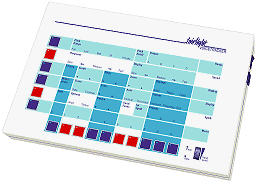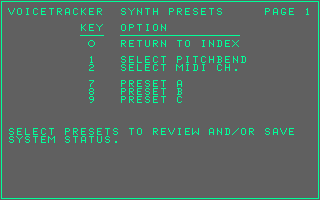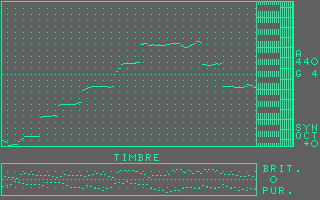
| Home | Web Design | Programming | Fairlight CMI | Soap Box | Downloads | Links | Biography | About... | Site Map |
 |
FAIRLIGHT VOICETRACKER VT-5 |
| Fairlight CMI |
Examples | Swap Shop | Messageboard | Tales | Images | Wild | Technology | [Voicetracker] |
News Flash |
· GH Services is the North American distributor for BassLab of Germany.
Click here
for these unique guitars and basses. · Horizontal Productions repairs and upgrades Fairlight CMIs from Series I to MFX2. Visit http://www.horizontal.co.uk/. |
|
FAIRLIGHT CMI |
In 1985, Fairlight Instruments introduced the Voicetracker VT-5, a device that allows you to operate MIDI and control voltage synthesizers with your voice or any monophonic instrument, rather than with a MIDI keyboard. It was priced at US$2495 when it first came out. |

The Voicetracker's 8MHz 68008 CPU analyzes an input signal to determine the pitch and harmonic content of the sound (such as dynamics and breathiness). It takes about 1ms plus several cycles of the incoming sound to determine the pitch. As you might guess, the pitch information is output as MIDI note values and analog control voltages, while the harmonic content analysis can be used to control a synthesizer's filters (among other things). The Voicetracker can be used to "double" parts, either live or from tape. The original sound can be either enhanced with the doubling sound, or replaced completely by it. The Voicetracker can follow the original pitch exactly, or quantize it to semitone steps. Like other Fairlight products, the Voicetracker was continually updated, so not all Voicetrackers have the same features. Within a year after its introduction, Fairlight added the capability to perform "intelligent harmonization" -- up to seven note harmony in a designated scale. You can create six harmony setups and switch between them in real time. This capability allows one singer to provide the sound of an entire choir. This is particulary effective if the synthesizer is patched through a vocoder, which imposes the singer's vocal characteristics on the synthesized sound. 
Either microphone- or line-level sound sources can be fed into the Voicetracker. These signals are fed right back out unaltered, so that they can be sent to a mixing console. Also, an audio source can be fed into the Voicetracker's voltage controlled amplifier. The digital inputs and outputs include MIDI in, out, and through. The Voicetracker can send MIDI note messages, along with key velocity, pitch bend, and other controls. There are also patchable footswitch jacks and a serial port for connection to a computer. The analog outputs (pitch, gate, envelope, brightness, and purity) run from 0 to +5V, with the pitch output at 1 volt per octave. The Voicetracker also contains a built-in synthesizer, with dual DCO and DCF, which is used primarily for practice. 
Although the box itself is a fairly attractive package, the video screen interface is a bit primitive looking. But perhaps that is not surprising considering that it was designed to appear on a relatively low resolution video (TV) monitor. The Voicetracker is essentially a single-purpose computer, but Fairlight did not feel that they needed to include a monitor. Perhaps if the Voicetracker were produced today, there would be a built-in LCD display on the unit. The screen resolution is only 320x200 pixels, so an LCD of that size would probably not add too much to the cost. 
When a video monitor (NTSC or PAL format) is connected to the Voicetracker the pitch information is presented in a scrolling display. The frequencies can be shown in reference to a simulated on-screen piano keyboard or a numerical scale. The scrolling speed and direction can be altered, a visual metronome can be enabled, and you can zoom in until the screen shows just two semi-tones. I'm not sure whether the Voicetracker was an original idea created by the Fairlight engineers or whether the technology was acquired and expanded upon, although the VT-5 designation of the first available model leaves me wondering what happened to Voicetrackers 1 through 4... |
|
Michael Topic, Former Project Lead for the Fairlight Voicetracker, was in charge of the development of the Voictracker through most of 1986. He contacted me and answered a few questions and filled in some names:
Looking back at the list of analog outputs (pitch, gate, envelope, brightness, and purity), seems to confirm Michael's recollection! He continues:
You thought right! |
| Image credits:
Voicetracker image - by Greg Holmes.
Block diagram - by Greg Holmes, based on Fairlight brochure.
Menu image - by Greg Holmes, based on Fairlight brochure.
Screen image - by Greg Holmes, based on Fairlight brochure. |
| Home | Web Design | Programming | Fairlight CMI | Soap Box | Downloads | Links | Biography | About... | Site Map |
| Send comments about this site to Greg at
ghservices.com@gmail.com All trademarks contained herein are the property of their respective owners All pages copyright © 1996-2008 GH Services™ Created 1998-03-10 Last updated 2006-04-23 |